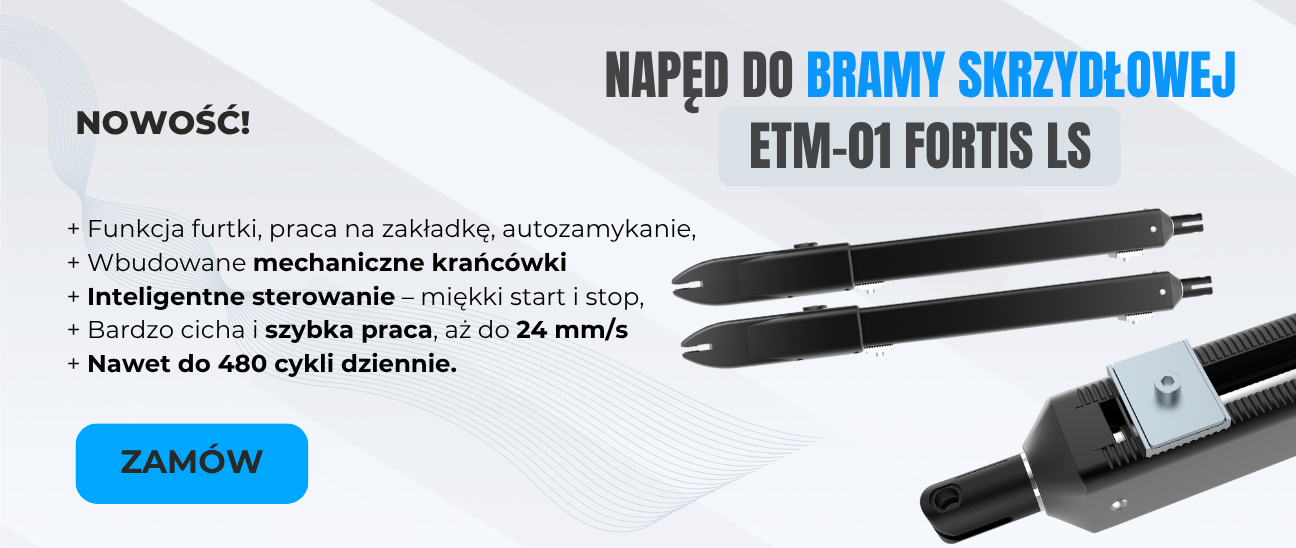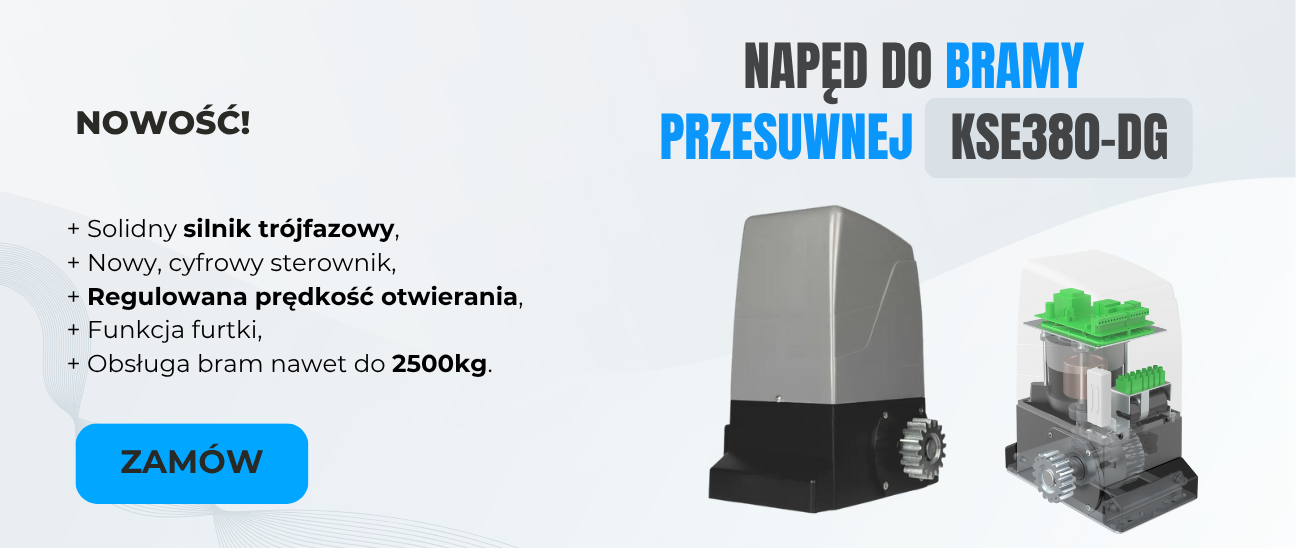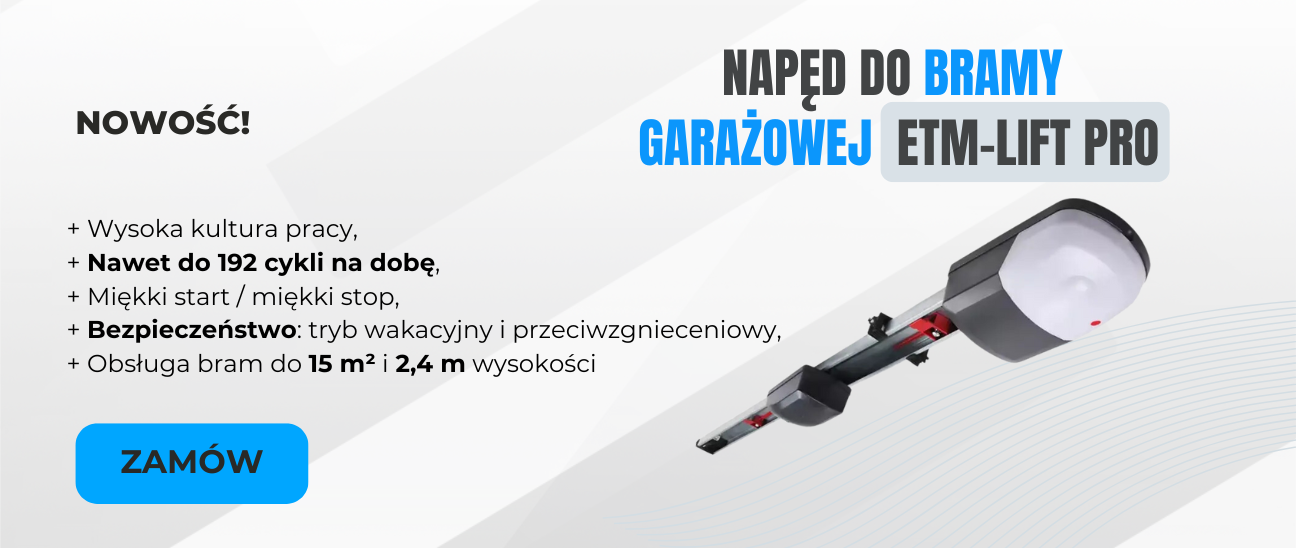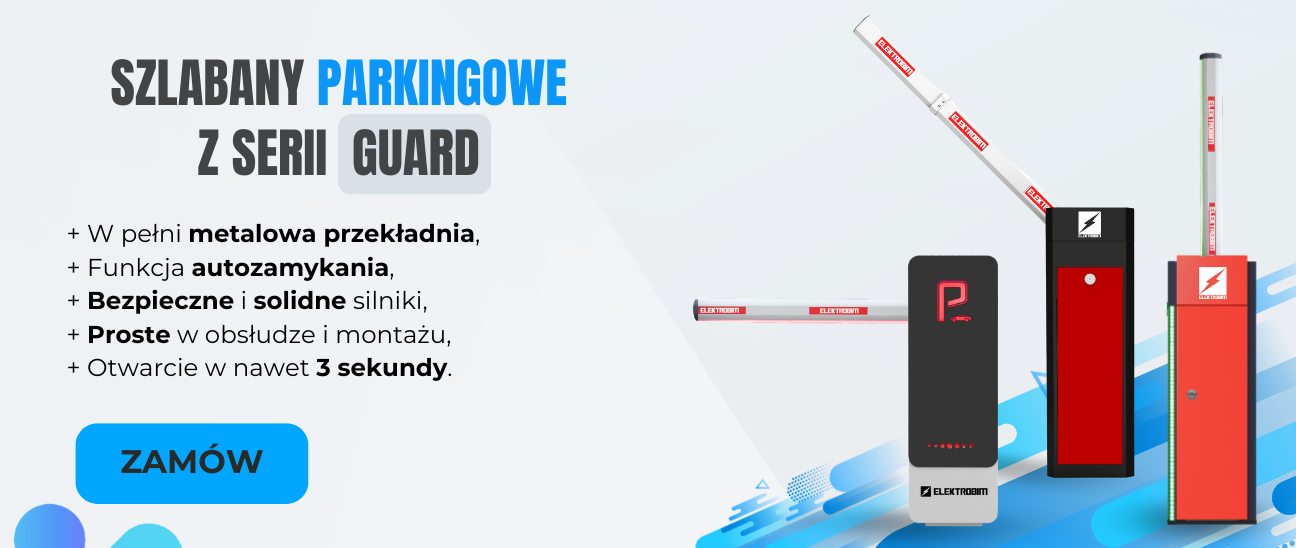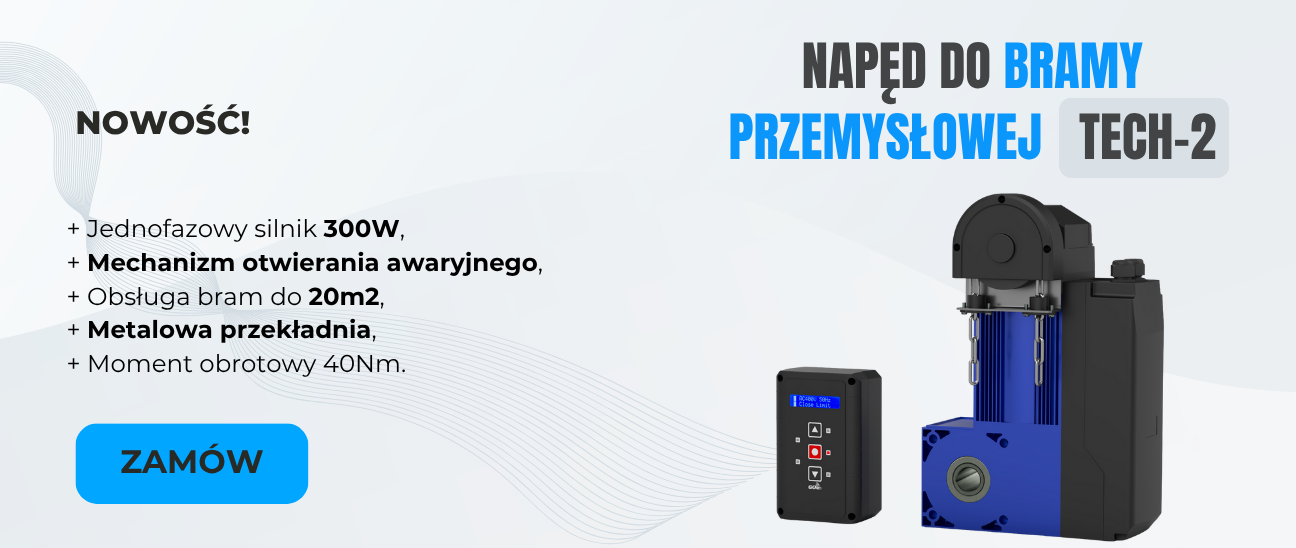Wpisy na blogu
Elektrobim – sklep internetowy i producent automatyki do bram i siłowników elektrycznych
Elektrobim to producent oraz dostawca wysokiej jakości napędów do bram, siłowników elektrycznych i kompletnych rozwiązań automatyzacji bram. Nasza firma zyskała zaufanie klientów dzięki innowacyjnym technologiom, solidności wykonania i zróżnicowanej ofercie produktów. W Elektrobim skupiamy się na dostarczaniu nie tylko produktów najwyższej jakości, ale również kompleksowego wsparcia technicznego oraz rozwiązań dostosowanych do indywidualnych potrzeb naszych klientów.
Napędy i automatyka do bram
Nasze napędy do bram stanowią fundament bezpieczeństwa i wygody w codziennym użytkowaniu. Dzięki precyzyjnym rozwiązaniom technicznym, oferujemy różne napędy, dostosowane do różnych rodzajów bram:
Napędy do bram skrzydłowych to nasza odpowiedź na potrzeby klientów ceniących elegancję i tradycyjny design. Wyposażone w zaawansowane mechanizmy, gwarantują płynność ruchu, przy jednoczesnym zachowaniu pełnej kontroli nad ruchem bramy. Elastyczność konstrukcji pozwala na instalację zarówno w przypadku małych bram domowych, jak i większych, przemysłowych konstrukcji.
Oferowane przez nas napędy do bram przesuwnych to doskonałe rozwiązanie tam, gdzie miejsce przed bramą jest ograniczone. Innowacyjne technologie zapewniają nie tylko płynne otwieranie i zamykanie, ale także precyzyjne dostosowanie prędkości ruchu, zależnie od indywidualnych preferencji użytkownika.
Napędy do bram garażowych stanowią naszą propozycję dla klientów poszukujących wygody i bezpieczeństwa w codziennym użytkowaniu garażu. Dostępne w różnych konfiguracjach, umożliwiają szybkie i ciche otwieranie oraz zamykanie bramy garażowej, dbając jednocześnie o trwałość i niezawodność.
Siłowniki elektryczne
Nasze siłowniki elektryczne to serce automatyzacji bram. Oferujemy szeroką gamę produktów, dostosowanych do różnorodnych zastosowań i wymagań:
Siłowniki do bram, które oferujemy, to efekt połączenia solidności z precyzją działania. Konstrukcje dostępne w różnych wariantach pozwalają na elastyczne dostosowanie do różnych rodzajów bram, bez utraty parametrów bezpieczeństwa i trwałości.
Nasza oferta obejmuje siłowniki elektryczne dostępne w różnych napięciach, co umożliwia ich integrację z różnorodnymi systemami elektrycznymi. Siłowniki elektryczne 12V, siłowniki 24V i elektryczne siłowniki 230V gwarantują nie tylko sprawne działanie, ale również oszczędność energii, dostosowując się do specyfiki danego projektu.
Dla klientów poszukujących rozwiązań niestandardowych, oferujemy siłowniki na zamówienie. Indywidualne podejście do projektów pozwala spełnić nawet najbardziej wymagające oczekiwania, zarówno pod względem funkcjonalności, jak i estetyki.
Siłowniki do biurek i stołów
W dziedzinie biurowej automatyzacji, oferujemy innowacyjne siłowniki do biurek i stołów, które rewolucjonizują sposób pracy, dostarczając nie tylko ergonomicznego designu, ale także technologicznej nowoczesności:
Elektryczny stelaż biurka ERB-1 ECO to odpowiedź na rosnące zapotrzebowanie na elastyczność w miejscu pracy. Dzięki możliwości elektrycznej regulacji wysokości, użytkownik może łatwo dostosować swoje miejsce pracy do indywidualnych preferencji, co wpływa korzystnie na zdrowie i komfort pracy.
Stelaż elektryczny ERB-2 to zaawansowane rozwiązanie dla osób, które oczekują najwyższego standardu obsługi. Elektryczna regulacja, programowalne ustawienia pozycji i estetyczny design to tylko niektóre cechy, które wyróżniają ten produkt na tle konkurencji.
Siłownik kolumnowy SK-48 to wszechstronne rozwiązanie dla stołów konferencyjnych i biurek wieloosobowych. Dzięki technologii pozwalającej na płynną zmianę wysokości, stanowi doskonałe narzędzie dostosowujące się do dynamicznych potrzeb współczesnych miejsc pracy.
Szlabany parkingowe
Szlabany parkingowe oferowane przez Elektrobim są nie tylko narzędziem kontroli dostępu, ale także elementem dbającym o estetykę przestrzeni parkingowej:
Szlaban na parking GUARD-1 PRO to solidny szlaban z ramieniem o długości 2 metrów, który gwarantuje efektywną ochronę terenu parkingowego. Solidna konstrukcja i precyzyjne wykonanie sprawiają, że szlaban ten to niezawodne rozwiązanie dla różnych miejsc.
Szlaban GUARD-2 to szlaban, który nie tylko zapewnia bezpieczeństwo, ale również przyciąga uwagę dzięki zintegrowanym diodom LED. Ramie o długości 5 metrów oraz efektowna sygnalizacja świetlna to cechy, które sprawiają, że GUARD-2 to doskonały wybór dla miejsc wymagających dodatkowego zabezpieczenia.
Szlaban parkingowy GUARD-3 to rozwiązanie dla obszernych terenów parkingowych, gdzie efektywna kontrola dostępu jest kluczowa. Długość ramienia wynosząca 6 metrów oraz solidna konstrukcja czynią go idealnym narzędziem dla obiektów o zwiększonym natężeniu ruchu.
Słupki parkingowe automatyczne
Automatyczne słupki parkingowe Elektrobim łączą w sobie funkcjonalność i estetykę, tworząc kompleksowe rozwiązanie dla zarządzania ruchem na obszarach parkingowych. Słupek parkingowy automatyczny BLK-1 to inteligentne rozwiązanie, które można sprawnie zintegrować z systemami sterowania ruchem. Automatyczne podnoszenie i opuszczanie słupek pozwala na elastyczną kontrolę dostępu, chroniąc jednocześnie teren parkingowy przed nieautoryzowanym ruchem.
Sterowanie do bram i siłowników
Elektrobim oferuje zaawansowane systemy sterowania, które są mózgiem każdego automatycznego rozwiązania. Nasze systemy sterowania do napędów do bram pozwalają na dokładne dostosowanie parametrów ruchu bramy. Programowalne funkcje, zdalne sterowanie i intuicyjna obsługa to cechy, które ułatwiają korzystanie z naszych produktów.
Dedykowane sterowanie do siłowników elektrycznych umożliwia kompleksową kontrolę nad ich pracą. Funkcje takie jak regulacja prędkości, ustawienia czasowe czy zdalne sterowanie sprawiają, że nasze rozwiązania są nie tylko efektywne, ale również łatwe w obsłudze.
Zasilacze do siłowników elektrycznych
Nasze zasilacze modułowe 12/24V to kluczowy element, który gwarantuje stabilne i bezpieczne zasilanie dla siłowników elektrycznych w różnych warunkach pracy. Dostępne w różnych konfiguracjach, pozwalają na elastyczną integrację z różnorodnymi systemami elektrycznymi.
Kontrola dostępu od Elektrobim
Elektrobim oferuje kompleksowe rozwiązania kontroli dostępu, które zabezpieczają różnorodne przestrzenie. Wśród nich dostępne są wideomofony, klawiatury szyfrowe czy karty i breloczki RFID. Systemy wideodomofonów umożliwiają dwustronną komunikację wizyjną, co pozwala na bezpieczną identyfikację osób znajdujących się przed bramą czy budynkiem.
Dedykowane klawiatury szyfrowe są idealnym rozwiązaniem tam, gdzie konieczne jest szybkie i bezpieczne wprowadzenie kodu dostępu. Odpowiednie zabezpieczenia sprawiają, że są one niezawodnym narzędziem kontroli dostępu. Zastosowanie kart i breloczków RFID pozwala na sprawną identyfikację, eliminując potrzebę tradycyjnych kluczy. Dedykowane systemy zarządzania pozwalają na skuteczną kontrolę dostępu do różnych obszarów.
Części i akcesoria do siłowników i automatyki bram
Nasz szeroki asortyment części i akcesoriów, w tym części do siłowników elektrycznych, części do automatyki bram oraz akcesoriów, takich jak fotokomórki, elektrozaczepy i inne pozwala na kompleksową obsługę naszych klientów. Oferujemy nie tylko wysokiej jakości komponenty, ale również fachowe doradztwo techniczne, wspierając naszych klientów na każdym etapie użytkowania naszych produktów.
Elektrobim to nie tylko producent – to partner, który dostarcza kompleksowe rozwiązania dla automatyzacji bram, siłowników elektrycznych i systemów kontroli dostępu. Nasze produkty są nie tylko efektywne i niezawodne, ale również zgodne z najnowszymi trendami technologicznymi, sprawiając, że każdy projekt staje się wyjątkowy i funkcjonalny.









